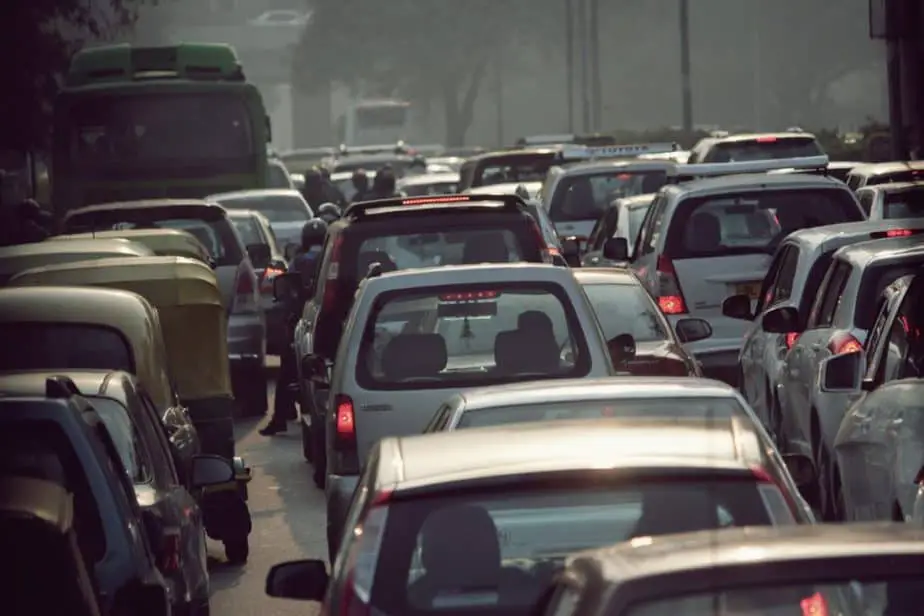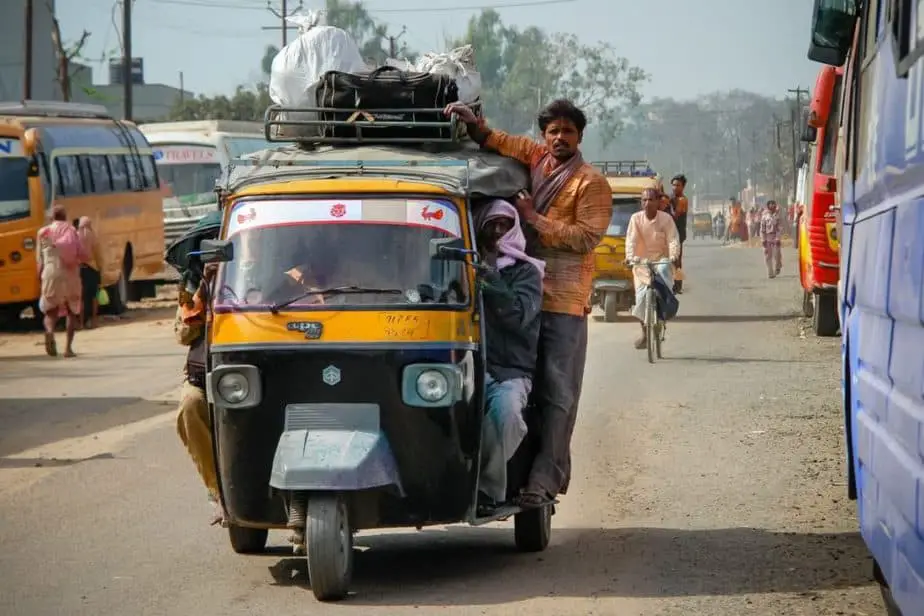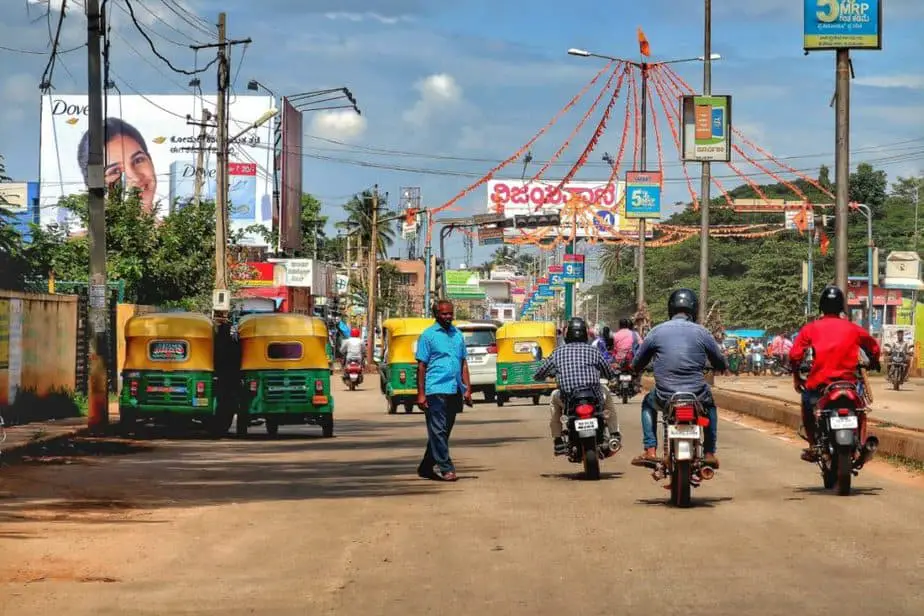My first ride in an Indian taxi was… breath-taking to put it mildly. It was 4 AM. We were driving in the big city of Chennai, avoiding large buses and semi-trucks, dodging cows, and stopping to ask sleeping rickshaw drivers for directions to my hotel (we couldn’t find it even with Google Maps!).
At some point early in my trip, I swore I would never drive in India… then a week later, I rented a scooter and off I went. Now I’ve been driving in India for over a year, and I’ve managed to survive and I would even say I’m a relatively polite driver. If you’re curious about how to drive politely, then read on.
Here is some basic driving etiquette in India: Use your horn as little as possible. If someone honks, let them pass. Use your signal AND arm when turning. Use low beam lights at night. Keep to the left of your lane. Expect to navigate around cows, horses, chickens, kids, potholes and more.
Disclaimer: Etiquette Should NOT Be Your First Priority When Driving in India

I know this post is specifically about being polite, but I think it’s important to mention that: safety comes first.
Driving in India can feel like it’s a “dog eat dog” world, so it is important you are appropriately assertive, or else you may be in more danger.
For example, if you’re coming up to a crossroads and there isn’t a sign or light, you will want to proceed assertively forward and look for a gap in the traffic, then go for it. Everyone’s used to this and will adjust. It actually might be more dangerous to stop and wait until it’s completely clear… because no one is expecting this so you may get hit from behind.
Another example is when you’re stuck in traffic. At times I’ve been surrounded by cars, rickshaws, motorcycles, and mopeds, and my strategy in those situations is to assertively move forward when I have the opportunity.
This is safer (and arguably more “polite”) is because that is what the other drivers will expect you to do. If you are tentative, then the other drivers may not be able to anticipate your next move… which is very important for your safety.
A Plea to the Drivers in India

Can’t we all just get along? Haha, driving in India can get pretty crazy especially in the big cities. With 1.37 billion people and only so many roads, it’s natural that things will get clogged and tense. But I’ve found that by being a polite driver most people will return that attitude. We all want to get where we’re going quickly and safely.
The National Crime Records Bureau reported that in 2015 there were 496,762 traffic collisions, which lead to 148,707 deaths. I’ve always felt that if I was going to get hurt in India that it would be while driving, so I hope these tips help you stay safe and do it with a polite style.
12 Tips To Be A Polite Driver in India

- Beep at crossroads and when passing. It’s polite to use your horn in India and people will expect it. Beep when passing or approaching a crossroad or blind turn. I use my horn if there are people clogging the road and they don’t see me coming. But just tap your horn, no need to slam in over and over and over…
- Size matters. Or get the heck out of the way of the big buses! The bigger the vehicle, the more you’ll be expected to move out of the way for them. Buses are the kings of the road. Then cargo trucks. Then SUVs and smaller trucks. Then cars. Then motorcycles. Then scooters. Then bikes. Then pedestrians. If I’m driving a scooter, I am always giving the buses a very wide berth and their screeching horn will emphasize that point if I ever forget.
- Use your turn signal and indicate with your arm. My turn signal dings loud enough for people nearby to hear. Then I also stick my arm to the side while waving my hand… similar to how you may pat someone on the top of their head. This two-pronged approach will make it especially clear you are turning since most people do not use their turn signal so they are not paying attention to that.
- Use your low beams at night. Unlike the USA, it’s common for drivers to keep their high beams on while approaching a vehicle from the opposite direction. Talk about blinding! I always switch my low beams and I’ve noticed that when I do so, the approaching vehicle will often do so as well.
- Keep to the left of your lane. It’s polite to pass on the right, so if you’re going slower keep to the left.
- Drive in the middle of the lane. Yet when I’m driving on country roads, I’ll drive in the middle of the road. I notice other motorists do the same. It’s easier to avoid people walking and cows while giving yourself space to maneuver on both sides.
- Let honkers pass. If someone honks aggressively, I try to let them pass. At times it can get annoying if a motorist is doing the beep-beep-beep-beep-beep-beep thing and I may have thoughts of shoving that horn someplace unpleasant, but it’s easier to just let them go by on their angry way.
- Expect obstacles in the road. I often see cars stopped in the middle of the road as they talk to a friend out of their window. There are plenty of cows, horses, chickens, dogs, cats, monkeys, kids, older people, potholes, rocks, mounds of dirt, puddles, mud holes, and I’ve even had to dodge a pig. It’s a part of the fun of driving in India.
- Don’t use your phone. Come on bro… I see guys talking on the phone and texting as they ride their motorbikes on these “interesting” dirt roads, and it’s not clear to me how they aren’t crashing. It is clear to me that I have to pay extra attention to avoid them since they’re not paying attention, so don’t be that guy.
- Wear a helmet, shoes and a shirt. I think this is polite because if you’re safe and prepared as you drive, you’ll be in a better headspace. I notice that I’m more chill when I’m not driving barefoot and worried about having to put my foot down (one time I did and stepped in a warm cow patty, which was slightly distracting for the rest of the ride 🙂
- Plan extra time. In the USA, you can accurately estimate the time it will take you to get to a destination by the equation: 1 mile = 1 minute. Therefore, if you’re going 60 miles away, it will take you about 60 minutes. That’s not the case in India. With fewer highways and more obstacles, it usually takes about 1 mile = 2.5 minutes. Sometimes more, sometimes less. Therefore if you’re going 60 miles it would take about 2.5 hours. It would be even more if you had to cross a big city. Leave early and be less stressed.
- Be relatively chill. This is for me because I have gotten annoyed at people sometimes… someone’s not following the rules, or cuts me off, or is stopped right in my way and I get an angry scowl on my face, then I’ll look up and it’s a smiling friend, haha. I always feel foolish in those situations. To them, there’s nothing wrong here because it’s not expected to always follow the traffic laws. Hey, when in India…
Driving in India can be a fun, even a spiritual experience. I love to hop on my scooter and drive out into the countryside. It’s a joy to see the kids run up to my bike to practice their English or to watch the farmers work their fields or the families living a simple life in the country.
By following these tips for polite driving it has made my experience even more worthwhile.
Related Questions:
Why is Driving in India so Bad?
There are 1.37 billion people and 382 people per square kilometer, so there are just a lot of people to contend with on the roads and that is the biggest factor. If you consider that it is also acceptable to not following the laws and there are a wide range of vehicles from scooters to rickshaws to bullock carts, then you will have an idea of the challenges of driving in India.
How To Drive A Car in India
If you’re a tourist, I wouldn’t recommend it. Hire a driver and let them deal with it (it’s ~900 RS in Delhi or less than $15 USD). If you are set on driving a car, then go to an Indian driving school. You can find them in big cities.

